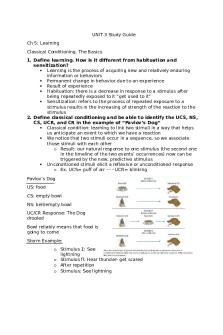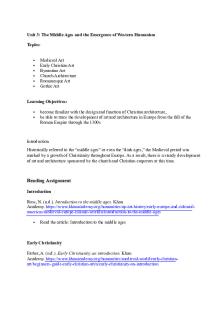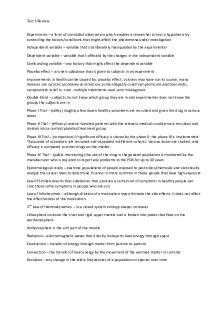MBL5905 Study UNIT 3 Dynamic strategy 2019 PDF

| Title | MBL5905 Study UNIT 3 Dynamic strategy 2019 |
|---|---|
| Author | Siyakudumisa Nondula |
| Course | Strategic Management |
| Institution | University of South Africa |
| Pages | 34 |
| File Size | 1.3 MB |
| File Type | |
| Total Downloads | 16 |
| Total Views | 165 |
Summary
Download MBL5905 Study UNIT 3 Dynamic strategy 2019 PDF
Description
MBL5905 Study Unit 3: Dynamic strategy
STUDY UNIT 3: DYNAMIC STRATEGY Module Leader: Professor Peet Venter Table of contents LIST OF FIGURES .................................................................................................................................. 2 LIST OF TABLES .................................................................................................................................... 2 THOUGHT PROVOKER ......................................................................................................................... 3 LEARNING OUTCOMES ........................................................................................................................ 3 KEY CONCEPTS .................................................................................................................................... 3 3.1 3.3
INTRODUCTION ..................................................................................................................... 4 DYNAMIC STRATEGY ............................................................................................................ 5
Activity 3.1 ............................................................................................................................................. 7 3.4
DYNAMIC CAPABILITIES ....................................................................................................... 8
Activity 3.2 ............................................................................................................................................. 8 3.5 3.6
THE IMPORTANCE OF A SHARED VISION .......................................................................... 9 BUSINESS LEVEL STRATEGIC DECISIONS ...................................................................... 11
3.6.1 3.6.2
What is business level strategy? ........................................................................................... 11 Competitive strategies ........................................................................................................... 12
Activity 3.3 ........................................................................................................................................... 17 3.7
CORPORATE LEVEL STRATEGIC DECISIONS ................................................................. 17
3.7.1
The scope of the corporation ................................................................................................. 18
Activity 3.4 ........................................................................................................................................... 20 Activity 3.5 ........................................................................................................................................... 22 3.7.2 3.7.3
The modes of corporate expansion ....................................................................................... 22 Managing the corporate portfolio ........................................................................................... 26
3.8
GLOBAL STRATEGIES......................................................................................................... 27
3.8.1 3.8.2 3.8.3
Home-base advantage .......................................................................................................... 28 Choice of country ................................................................................................................... 28 Global organisational strategy ............................................................................................... 29
3.9 3.10
EVALUATING STRATEGIES ................................................................................................ 32 CONCLUSION ....................................................................................................................... 33
Page 1 of 32
© UNISA Graduate School of Business Leadership
MBL5905 Study Unit 3: Dynamic strategy
List of figures Figure 3.1 The focus of Study Unit 3 ...................................................................................................... 4 Figure 3.2 Dynamic strategy ................................................................................................................... 5 Figure 3.3. The need for developing resources and capabilities ............................................................ 7 Figure 3.4 Dynamic capabilities and dynamic strategy ........................................................................... 9 Figure 3.5 Considerations in global expansion ..................................................................................... 28 Figure 3.6 Global organisational strategy as a response to conflicting pressures ............................... 30
List of tables Table 3.1: Business and corporate level strategy ................................................................................. 12 Table 3.2 Modes of corporate expansion .............................................................................................. 23 Table 3.3 Corporate value creation versus value destruction............................................................... 27 Table 3.4 Global organisational strategy archetypes ............................................................................ 31 Table 3.5 Guidelines for evaluating strategies ...................................................................................... 33
Page 2 of 32
© UNISA Graduate School of Business Leadership
MBL5905 Study Unit 3: Dynamic strategy
THOUGHT PROVOKER Watch the video on Tesla Motors at: https://www.youtube.com/watch?v=KA18tusTgE4 How did Tesla’s strategy for the automotive industry evolve over time? What are the key elements of success for each phase?
LEARNING OUTCOMES After completing this study unit, you should be able to critically evaluate the strategic choices of an organisation from a dynamic strategy perspective. You should demonstrate that you can: • Explain what dynamic strategy entails • Demonstrate the importance of dynamic capabilities in dynamic strategy • Explain the importance of a shared vision in strategy formation • Critically analyse the business level, corporate level, and global strategic decisions of an organisation from a dynamic strategy perspective • Assess the impact of strategic choices on business performance
KEY CONCEPTS • • • • •
Page 3 of 32
Business level strategy Corporate level strategy Generic strategy Competitive strategy Global strategy
© UNISA Graduate School of Business Leadership
MBL5905 Study Unit 3: Dynamic strategy
3.1
INTRODUCTION
In this study unit we focus on the development of strategy as strategic leaders in organisations make strategic choices. The nature of the development of strategy evolutionary, rather than being made up of purely rational choices. Accordingly, this study unit focuses on the “process” and “content” components of strategy formation (see Figure 3.1).
SCANNING AND CONTROL STRATEGY FORMATION
STRATEGISING
ORGANISATIONAL ARCHITECTURE
ORGANISATIONAL LEARNING
RESOURCE ALLOCATION
CHANGE MANAGEMENT
SCANNING AND CONTROL
Figure 3.1 The focus of Study Unit 3
In the next section we explore the evolutionary nature of strategy development.
Page 4 of 32
© UNISA Graduate School of Business Leadership
MBL5905 Study Unit 3: Dynamic strategy
3.3
DYNAMIC STRATEGY Study the video lecture: Competing on capabilities in a global world: the RAT/CAT framework
Large organisations do not form overnight – they start off as small businesses, and as they succeed, they grow and expand. From an evolutionary perspective, we can argue that businesses most often start off because they have identified some opportunity in the external environment. If they succeed, they may develop some unique resources and capabilities – in other words, internal sources of competitive advantage. The replication of these resources and capabilities in other markets, products and geographical areas provides the basis for their growth and expansion. This replication typically requires large commitments of resources to strategic initiatives, most often to expand the scope of the business. For example, when South African Breweries acquired Miller in the USA, they acquired a much bigger company than themselves. As businesses grow and expand, their key resources and capabilities evolve and grow more valuable over time, and they develop new resources and capabilities. As this process is repeated over and over again, the value of resources and capabilities will continue to grow, provided that the right decisions are made. Poor decisions, on the other hand, may lead to large scale reductions in the value of the organisation’s strategic resources and capabilities. In the video lecture, this effect is evident for CEMEX with the Rinker acquisition. More locally, consider Telkom’s Multi-Links investment (https://www.timeslive.co.za/news/south-africa/2011-06-20-dear-telkom-i-told-you-so/). This investment was clearly not a good strategic decision, and it subsequently led not only to great financial losses but also to substantial reputational damage to Telkom. This notion of dynamic strategy is depicted in Figure 3.2. After studying this section, you should be able to explain what dynamic strategy entails.
Value of resources and capabilities
Activities and organisational learning
Strategic commitments
Figure 3.2 Dynamic strategy
Page 5 of 32
© UNISA Graduate School of Business Leadership
MBL5905 Study Unit 3: Dynamic strategy
Reflection Let’s consider South African Breweries as an example. This globally successful brewing company started out as a small brewery in the gold mining town of Johannesburg in 1895, with Castle Lager as its only brand. In 1902, the company expanded internationally for the first time when it established Rhodesian Breweries in Rhodesia (Zimbabwe). In 1917 it first expanded in terms of scope when it acquired Union Glass, a strategic move to ensure the supply of glass during a time when there was an acute shortage of glass. These strategic moves were early signs of a series of strategic decisions over many years that saw the company grow into a multi-business corporation though mergers, acquisitions and investments in new regions and businesses, becoming first a dominant regional competitor in Southern Africa and eventually, after acquiring Miller in the USA, a global brewing company (SABMiller), one of the largest in the world. Even today, SABMiller’s quest for competitive advantage continues as it strives to achieve success in emerging markets such as China and India (SABMiller, 2013). Yet another chapter in the strategic development of SABMiller is looming as the company has accepted an offer from Anheuser-Busch InBev NV for $104.2 billion, a 50% premium over SABMiller’s share price as at September 14 2017. The strategic decisions exhibited by SABMiller are characteristic of a company continually striving to create shareholder value through successful individual businesses, expanded corporate scope and a global presence1.
The development of new resources and capabilities is often the natural result of strategic direction. This requirement is depicted in Figure 3.3. As organisations outgrow their situation, they may need to develop new resources and capabilities to address changing key success factors. Very often it is possible to both exploit current resources and capabilities and to acquire new capabilities, as the next example illustrates. At first, South African Breweries developed strong capabilities in branding and running efficient operations in South Africa. They were able to replicate these capabilities in several African countries to establish a strong regional presence, and developed capabilities to operate in emerging markets. With the Miller acquisition, they needed to develop the capabilities to succeed in the First World, and to become a true multinational corporation (MNC).
Page 6 of 32
© UNISA Graduate School of Business Leadership
MBL5905 Study Unit 3: Dynamic strategy
STRATEGIC DIRECTION
FUTURE KEY SUCCESS FACTORS
CURRENT KEY SUCCESS FACTORS
REQUIRED RESOURCES AND CAPABILITIES
ACQUIRE NEW
FIT?
CURRENT RESOURCES AND CAPABILITIES
EXPLOIT CURRENT
Figure 3.3. The need for developing resources and capabilities
Activity 3.1 Watch the video on Tesla Motors at: https://www.youtube.com/watch?v=KA18tusTgE4 Use the frameworks in this section to determine if Tesla has a dynamic strategy. Provide specific evidence from the case video to support your answer.
In summary, dynamic strategy is about constantly developing new resources and capabilities to address changes in the environment and to sustain competitive advantage. However, dynamic strategy is not possible without dynamic capabilities, a construct we discuss in the next section.
Page 7 of 32
© UNISA Graduate School of Business Leadership
MBL5905 Study Unit 3: Dynamic strategy
3.4
DYNAMIC CAPABILITIES Study the prescribed book: Chapter 7 Study the video lecture: Competing on capabilities in a global world: the RAT/CAT framework Study the article: Teece, DJ. 2007. Explicating dynamic capabilities: The nature and microfoundations of (sustainable) enterprise performance. Strategic Management Journal 28(13): 1319–1350.
In Study Unit 2 we explored the importance of resources and capabilities as building blocks of competitive advantage. However, there is one category of capability that we have not yet fully explored, despite its importance for strategy and competitive advantage. Dynamic capabilities are those capabilities that allow organisations to change and adapt to their environment or to new strategic directions by developing new capabilities. Without dynamic capabilities, dynamic strategy would simply not be possible. According to David Teece (see prescribed article), dynamic capabilities consist of three aspects: • • •
Sensing opportunities Seizing opportunities Transforming opportunities and managing threats
Figure 3.4 depicts the interrelationship between dynamic capabilities and dynamic strategy. Some examples of dynamic capabilities include product development, alliance-building and – arguably the most important (from our perspective) – strategic decision-making. After studying this section, you should be able to demonstrate the importance of dynamic capabilities in dynamic strategy. Activity 3.2 Select any organisation that you are familiar with. Use the framework in the prescribed article (see summary on p 1342) to assess its dynamic capabilities.
Page 8 of 32
© UNISA Graduate School of Business Leadership
MBL5905 Study Unit 3: Dynamic strategy
Value of resources and capabilities
Sensing opportunities
Activities and organisational learning
Strategic commitments
Transforming opportunities
Seizing opportunities
Figure 3.4 Dynamic capabilities and dynamic strategy
3.5
THE IMPORTANCE OF A SHARED VISION Study the prescribed book: Chapter 3
A clear strategic direction provides the boundaries and guidelines for the sensing, seizing and transforming activities of the organisation. For that reason, it is commonly agreed that a shared vision is a key component of successful strategy. Successful strategic leaders generally have a vision that they are able to get the other members of the organisation to commit to (see the example of Elon Musk in the reflection box below), and to break the vision down into more achievable goals, as Musk has done with his 2006 and 2016 “master plans”. Strategic direction provides certain boundaries and rules that clarify what the organisation will do, and perhaps even more importantly, what it will not do. For example, Elon Musk essentially gave away the Hyperloop train concept because it does not fit with his strategic focus. Many strategy textbooks espouse the importance of written statements of strategic direction, such as a vision statement, a mission statement and a statement of organisational values. However, these statements mean very little if they are not internalised by the members of the organisation. After studying this section, you should be able to explain the importance of a shared vision in strategy formation.
Page 9 of 32
© UNISA Graduate School of Business Leadership
MBL5905 Study Unit 3: Dynamic strategy
Reflection In 2006, Elon Musk announced in a blog his “master plan” for sustainable mass transport: 1. 2. 3. 4.
Create a low volume car (which would necessarily be expensive) Use that money to develop a medium volume car at a lower price Use that money to create an affordable, high volume car Provide solar power
As one of the most admired technology entrepreneurs in the world, South African-born Musk is known for his vision to rid the world of fossil fuels, and Tesla’s electric vehicles and solar power technologies are ways to do just that. In pursuit of his vision for a sustainable planet, Musk does not hesitate to share his ideas and technologies freely and to think out of the box. He has made Tesla Motors’ patents available to the industry free of charge and has explicitly open sourced the Hyperloop train concept so that others can take the ideas and further develop them. In addition, he is striving to make travel to Mars affordable with Space-X and to establish a space colony on Mars. Musk is often described as a transformational leader who has the following qualities: • • • •
Thinking beyond what seems possible or viable today The ability to make people believe in his vision, no matter how farfetched it may seem Leading by example - excellence is non-negotiable A relentless (even obsessive) drive towards results – failure is not an option
In 2016, Musk updated his master plan as follows: 1. Create stunning solar roofs with seamlessly integrated battery storage 2. Expand the electric vehicle product line to address all major segments 3. Develop a self-driving capability that is 10x safer than manual via massive fleet learning 4. Enable your car to make money for you when you aren't using it With his track record up to this point, it would not be wise to bet against him achieving exactly what he sets out to do2.
Up to this point we have focused more on the processes and conditions for developing strategy. In the next sections we will focus on the content of strategy, starting with business level strategy.
Page 10 of 32
© UNISA Graduate School of Business Leadership
MBL5905 Study Unit 3: Dynamic strategy
3.6
BUSINESS LEVEL STRATEGIC DECISIONS
In the sections that follow we discuss the various strategic options that are available to organisations. You should be aware that these options are not necessarily the only options available to an organisation, and that creativity in devising innovative strategies and tactics can also contribute to strategic success. Study the prescribed book: Chapters 6 and 8 Study the video lecture on Competitive Strategy by Prof Robert Grant at: https://hstalks.com/t/2548/competitive-strategy/?business
3.6.1
What is business level strategy? Key concepts Compe...
Similar Free PDFs

Dynamic Study Modules
- 9 Pages

Unit 3 study guide - unit test 3
- 3 Pages

UNIT 3 Study Guide
- 19 Pages

Unit 3 Study Guide
- 4 Pages

Unit 3 Study Questions
- 12 Pages

Unit 3 Study Guide - notes
- 8 Pages

Study unit 3 221 - fewf
- 3 Pages

Student Study Guide Unit 3
- 13 Pages

SWE40002 Unit of Study Outline 2019
- 10 Pages

Final Study Guide Strategy
- 20 Pages
Popular Institutions
- Tinajero National High School - Annex
- Politeknik Caltex Riau
- Yokohama City University
- SGT University
- University of Al-Qadisiyah
- Divine Word College of Vigan
- Techniek College Rotterdam
- Universidade de Santiago
- Universiti Teknologi MARA Cawangan Johor Kampus Pasir Gudang
- Poltekkes Kemenkes Yogyakarta
- Baguio City National High School
- Colegio san marcos
- preparatoria uno
- Centro de Bachillerato Tecnológico Industrial y de Servicios No. 107
- Dalian Maritime University
- Quang Trung Secondary School
- Colegio Tecnológico en Informática
- Corporación Regional de Educación Superior
- Grupo CEDVA
- Dar Al Uloom University
- Centro de Estudios Preuniversitarios de la Universidad Nacional de Ingeniería
- 上智大学
- Aakash International School, Nuna Majara
- San Felipe Neri Catholic School
- Kang Chiao International School - New Taipei City
- Misamis Occidental National High School
- Institución Educativa Escuela Normal Juan Ladrilleros
- Kolehiyo ng Pantukan
- Batanes State College
- Instituto Continental
- Sekolah Menengah Kejuruan Kesehatan Kaltara (Tarakan)
- Colegio de La Inmaculada Concepcion - Cebu





